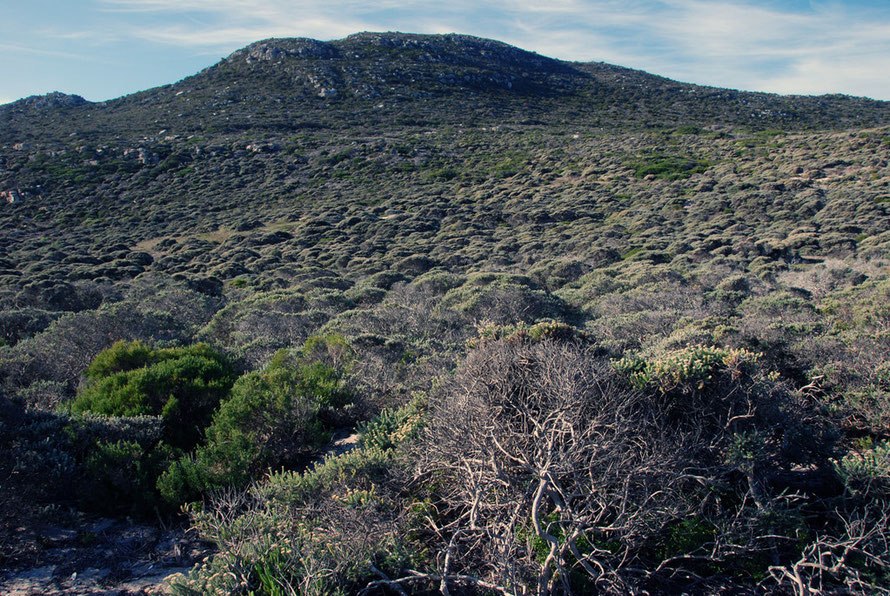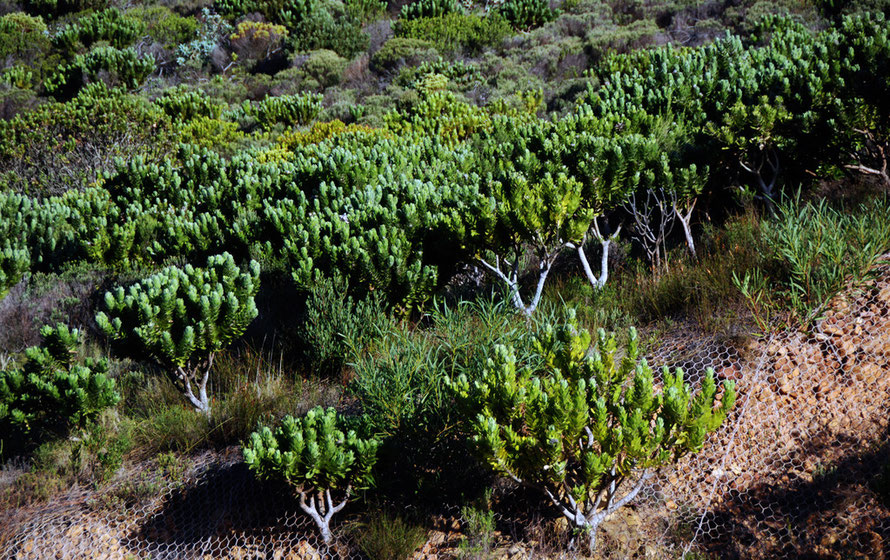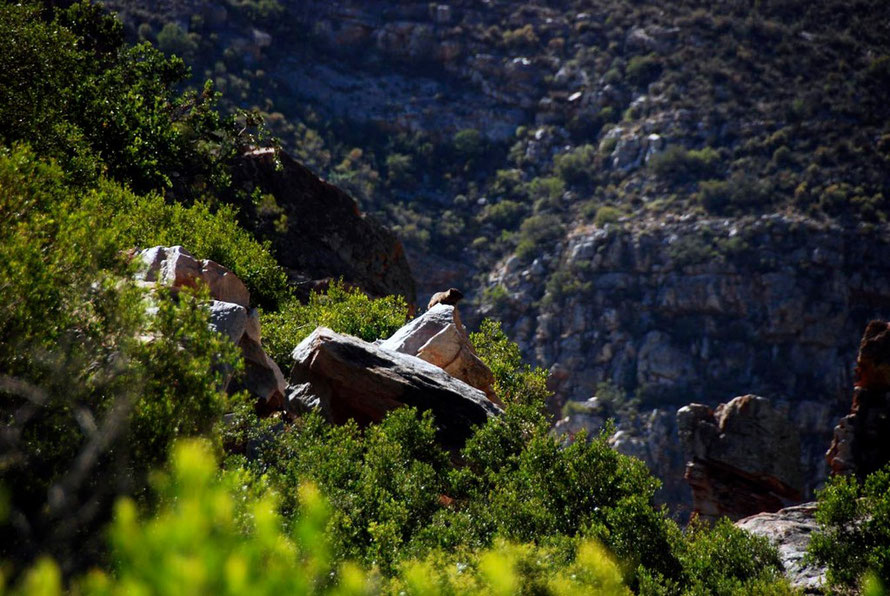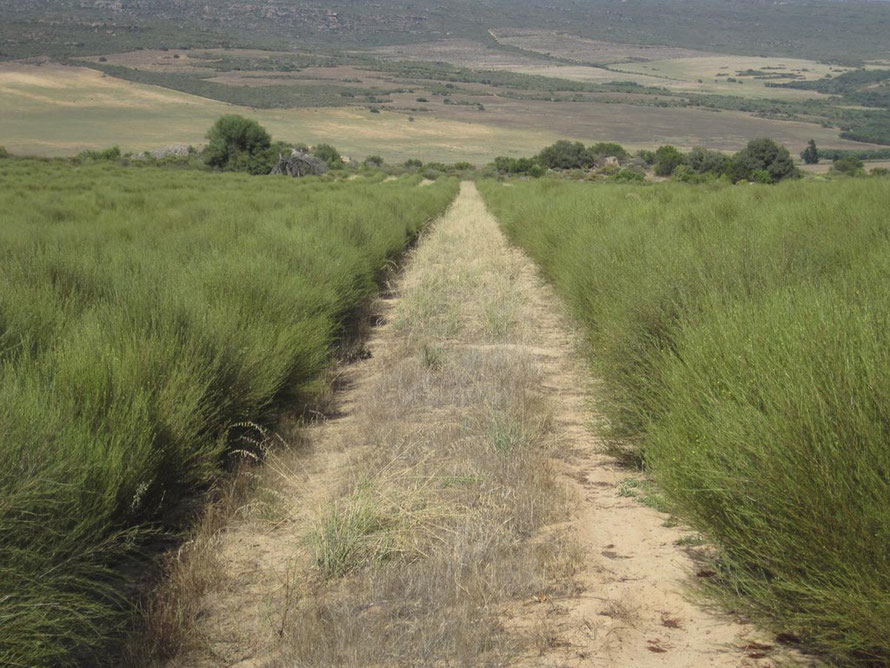II. The Fynbos Vegetation of the Cape Floral Region
Fynbos comes from the Dutch for ‘fine-bush’. It is a heath landscape and is largely devoid of trees. In some respects it is not dissimilar to a heather moor with gorse. Charles Darwin described it as 'heath' on his way by pony cart from Simon's Town to Cape Town at the end of May 1836. He commented in his diary that ‘the country is very desert; and with the exception of the pleasure which the sight of an entirely new vegetation never fails to communicate, there is very little of interest.” It was coming on to winter, after all, and he had arrived fresh from New Zealand, Australia and Tahiti (Mail and Guardian 27 November 2009 and see this contemporary illustration of Darwin at Simon's Town).
The major difference, other than the much greater biodiversity, between a heather moor and fynbos is the relative absence of summer rains. As such fynbos bears some similarities with other Mediterranean climate nutrient-poor soil vegetations types, such as maquis or garrigue. (See for example, the Akamas peninsula in Cyprus on this site.)
Fynbos comes in many varieties depending on variables such as soil type and rainfall and is often associated with dramatic upland landscapes, particularly as lowland fynbos types – such as sand and strandveld fynbos – are much more vulnerable to degradation through agriculture and development.
I have been trying to work out why I liked the fynbos areas we visited so much. Fynbos is at most shoulder- or head-high but often little more than waist-high. And it is sparse and varied rather than thick and monotonous. It is also generally benign to human passage.
Summer droughts and lack of nutrients have promoted a plant strategy known as sclerophylly. Plants develop long-lived, tough, low-nutrient leaves capable of resisting desiccation. This results in carbon-rich, woody foliage that lacks sufficient nitrogen to make it viable for animal utilisation. This makes the usual defences against grazing animals – such as thorns, spikes and leaf chemicals unnecessary (see Mucina and Rutherford, The Vegetation of South Africa, Losotho and Swaziland 2010 Vol I, p. 86).
So fynbos is a benign, varied, waist- to shoulder-high heath-type vegetation that is like the sparse and ruffled fur on the body of its often dramatic upland, rocky landscapes. As such it is easily punctured and pulled about by landscape features like rock formations, tors (kopjes in Afrikaans) peaks, cliffs and escarpments. But where it differs dramatically from say a temperate zone Western Heath is in the incredible variety of its plant-life.
This is not primarily, at least in visual terms, an issue of huge biodiversity and speciation, but rather an issue of the architecture/structure of the different plants. Proteas have distinctive pared-down stem and branch structures; they seem like mythical, miniature trees-symbols. Restios have the wispy frail elegance of reeds or bamboos without their threat of dominance and impenetrability. And the Ericas are smaller, denser, often ground-hugging masses of vegetation.
At the Cape this low lying, varied plant architecture is enlivened by the South Easterly trade winds that whip off the Indian Ocean in the summer. They set up a beautiful tension between the solidity of the rocky landscape and the blur and bounce of wind-tossed plants. Add to this the clarity of sea air, the heat of the sun and the over-powering blue of the arching sky that seems to reach out to distant Brazil and Antarctica and the picture is almost complete. Because mixed into this landscape come the antelopes (albeit at a low incidence per hectare) and ostrich, baboons and zebra, the sunbirds and stonechats. And once behind them came ancient man, the Khoikhoi, with spear and bow and arrow and a system of knowledge built-up over millennia living in a symbiotic relationship with this landscape, flora and fauna (see Slaughter, Slavery and Segregation on this site).
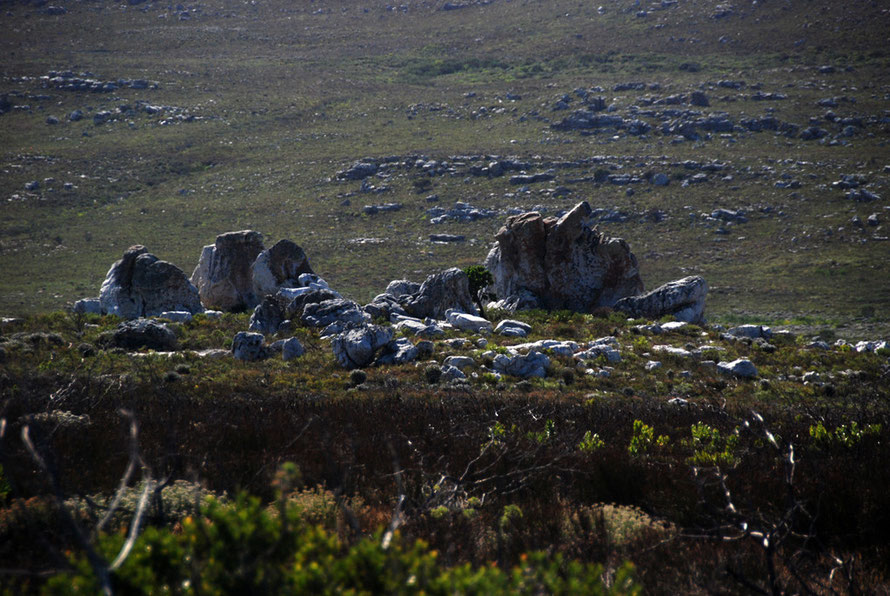
Another feature of fynbos is the incidence of fire. Fynbos is a fire-maintained eco-system. In particular, fire is essential for fynbos reproduction in that many plants have evolved a unique strategy of serotiny in which species retain seeds in fire-proof seedheads and only release them after a fire. This strategy can only work if fire-return is predictable and is greater than 5-year fire intervals. (see Mucina and Rutherford above p.79.) Regular burning prevents plants from becoming old and straggly: there is a youth and freshness to the fynbos biome that is striking.
Welsh (History of South Africa, 2000 p.29) says the Khoikhoi at the Cape in the 17th century ‘moved inexorably with the seasons, burning the grass after them to ensure new growth.’
The greens are not the tired, dark, brooding leaf-greens of mid-summer British deciduous trees but are lighter and infused with yellows, and lime, and slatey blues and the flashing silvers of some of the proteas.
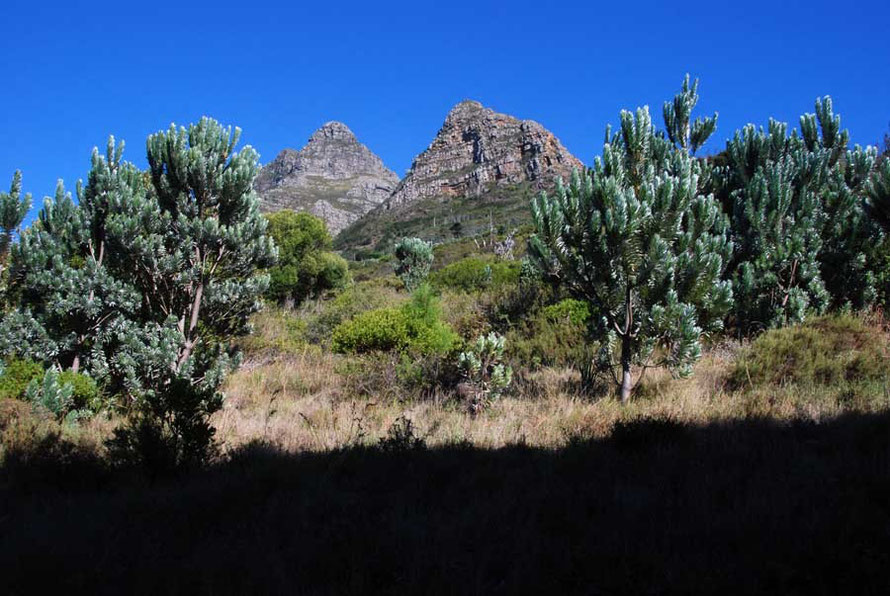
Leucadendron argenteum (Silver tree, Silver leaf tree, Witteboom, or Silwerboom) is a giant protea. An endangered species it is endemic to a small area of the Cape Peninsula, in and around the city of Cape Town. I happened to stumble across the largest area of Silver Trees that stand just outside a pine grove above the Rhodes Memorial.
A further fynbos plant strategy adds to the freshness and vigour of the landscape. This is located in the tendency to reseed rather than resprout after fire. ‘Because of the predictable fire-return interval, fynbos shrubs appear to invest all their resources in seed production rather than regeneration' (Mucina and Rutherford p.79).
Debate continues at to the importance of large herbivores in the maintenance or transformation of fynbos vegetation. There was certainly a rapid decline to near extinction of most herbivores in the Cape Floral Region between the arrival of the first colonists and 1800. Whether or not these grazed or browsed on fynbos, which is notoriously nitrogen-poor and woody, is a moot point. It may rather be that herbivores migrated through the fynbos rather than lived off it, as such. There is some evidence that antelopes such as Bontebok do not thrive when confined to fynbos as opposed the nitrogen-richer renostoveld (see my Bontebok page).
Early colonist diary entries attest to the domestic herbivores (sheep and later cattle) kept by the Khoi khoi people of the Cape for two millennia but it is unlikely these herds were confined to the fynbos when richer lowland pastures were available. There will always be the temptation if domestic stock are located on fynbos to increase the fire-cycle to promote the growth of succulent grasses at the expense of fynbos cover, with associated problems of erosion and rapid water loss.
Plant diversity in the Cape Floral Region is exceptional. It is the richest temperate flora in the world. The multiplicity of species – 9,000 – and their high percentage of endemism – 69% - is comparable with many of the richest tropical forests in the world.
The table below, painstakingly transcribed, taken from Mucina and Rutherford's, The Vegetation of South Africa, Losotho and Swaziland 2010 Vol I, summarises some of the mechanisms and underlying factors that have made the great plant diversity of fynbos and the Cape Floral Region possible.
Relative stability of climate over 5-15 million years, and the patchiness of the landscape in terms of climatic and topographical heterogeneity have combined with the strategies that plants in the biome have evolved - such as reseeding rather than sprouting, limited seed dispersal often by ants rather than dispersal by wind or birds and fire-stimulated cohort destruction and germination - to create short plant generation cycles that could evolve relatively quickly to fit the particular niches in which they were situated.
Table showing the factors and mechanisms underlying the rapid and localised diversification of the Cape Flora from Mucina and Rutherford, 2010
| Extent |
Mechanism of fine-scale subdivision |
Underlying Factors | |
| Spatial Component |
+90 000km/sq small by global standards |
Landscape Patchiness | Climatic diversity |
| Topographical heterogeneity | |||
| Fire-derived age mosaics | |||
|
Limited seed dispersal |
Limited investment in dispersal, determiined by low productivity | ||
|
Packing of individuals and species |
Small plant stature and niche separation | ||
| Temporal Component | 5-15 million years of relatively high climatic stability | Short generation time | Connected to fire and small plant stature |
|
Separation between generations |
Fire-driven simultaneous cohort death |
The economic uses of fynbos
As the understanding of the uniqueness of the fynbos biome and the threats it faces, particularly from invasive species, have increased so has a concern to measure the economic value of the habitats that make up the 9 500 km sq2 of the Cape Floral Region. This in part seems to have been driven by the need to secure budgetary allocations to the costly process of removing those invasive species.
There are 5 areas of value extraction that have been identified. These range from the small-scale and relatively easily measured to the more abstract and less-easily measured.
- The collection and processing of fynbos products – wildflowers, buchu (Agathosma betulina and Agathosma crenulata) for aromatic oils, and restio reeds for thatch and and various traditional and commercially marketed medicinal plants.
- The cultivation of fynbos plants for commercial harvest such as the production of rooibos (red-bush) tea in the Cedarburg Mountains, the trade in proteas as cut flowers and the propagation of fynbos plants as garden plants.
- The amelioration of water supplies to the Western Cape – fynbos vegetation has a low biomass per hectare and makes low demands on ground water while also helping to capture winter rains and reduce run-off. It has been estimated that invasive species such as pines, eucalypts and hakeas can increase biomass per hectare by 1000% and reduce water production by 30-100%.
- The generation of revenue from tourism, whether as hiking activity and gate receipts or eco-tourism or more general tourism to which the beauty of the Western Cape and the Cape Floral Region is a compelling backdrop.
- The potential to generate value from the Cape Floral Region’s function as a storehouse of genetic variation. (For above see Higgins et al 1997 and Cape Action.)
Natural resource economists have estimated the total economic value of the fynbos region as over R10 billion per year in 2005, the equivalent of over 10% of the Western Cape province’s Gross Geographic Product at the time.
However, realising that value and mobilising its potential in the pursuit of conservation resources has it challenges. Namely, ‘the public good character of so many of the fynbos ecosystem services mean that governments end up looking after it, … this means that investment in fynbos starts to compete with so many other public services' (see De Wit 2009). And that is not easy in post-Apartheid South Africa.
Fynbos threats
Fynbos habitats are threatened by four dangers: development, agriculture, invasive species and climate change. Luckily much montane fynbos is situated on poor soils in inhospitable terrain and even on the Cape Peninsula it has so far weathered the great expansion of the city. This however is not the case with lowland fynbos types and renostoveld. The huge expansion of habitation on the Cape Flats initially brought about by Apartheid and latterly by migration from the east of the country to Cape Town has severely reduced the area of Cape Flat sand fynbos.
Again, agriculture tends to impact most on lowland fynbos that grows on cultivable soils. Most of the huge expanse of lowland renostoveld disappeared under the plough a long time ago. There are also threats from marginal farming in upland fynbos areas through either domestic stock or possibly game farms where there is a tempatation to over-stock and over-burn in the hope of increasing the growth of succulent grasses at the expense of woody, unpalatable fynbos vegetation.

The variation of particular fynbos types is remarkable and dependant on rock and soil types. These vary from sandstone through limestone to granites and from poor shaley soils to leached-out geologically old sands and more more recent calcium-rich sandvelds. On top of this rainfall occurence and amount varies - generally getting less with northward travel.
Invasive species can quickly shade out low-lying fynbos plants and this is dealt with in more detail on the Invasion and Fire page in this section. The fire-dependence of fynbos also becomes an issue when urban areas and fynbos abut each other.
Global warming perhaps poses the greatest threat not only to the fynbos biome but also to the inhabitants of Southern Africa. Recent research (see below) raises great concern about a possible shift in the westerly winds that bring the west coast of South Africa its predominant winter rains. Should these move south it would spell potential disaster for fynbos species such as Proteas.
The great sprawl of Mitchell's Plan and Khayelitsha townships on the inhospitable Cape Flats bordering False Bay created by the forcible clearances of District Six in Cape Town and the legacy of Apart
'What they found supports an unsettling conclusion that sophisticated climate models have been suggesting for the future of the Cape. As the planet warms due to build-ups of heat- trapping greenhouse gases, winter rainfall is likely to become scarcer as well, primarily because of expected shifts in the meandering belt of westerly winds that circles Antarctica and brings rainstorms to the Cape in winter. The belt shifts its position closer to or farther from Antarctica with the seasons: cooler months drive it farther north over the Cape, carrying the life-giving rains with it, and warmer summer months draw it offshore where the rainstorms can no longer strike land.'
...
American researcher Curt Stager, lead author on the paper, Precipitation variability in the winter rainfall zone of South Africa during the last 1400 yr linked to the austral westerlies, said: “A poleward retreat of the austral westerlies would have serious societal and ecological consequences for the winter rainfall region of South Africa. The same also appears to be true for the semi-arid winter rainfall regions of South America and Australia-New Zealand.” (see UCT May 2012).
And from the Union of Concerned Scientists
All told, scientists find that more than half of protea species are at highest risk of becoming extinct as the climate of the Cape Floral Region changes. Given a mid-range scenario for heat-trapping emissions, global warming could cause 21-40 percent of the Proteaceae family to disappear, with the higher end of the range occurring if the species do not disperse.

